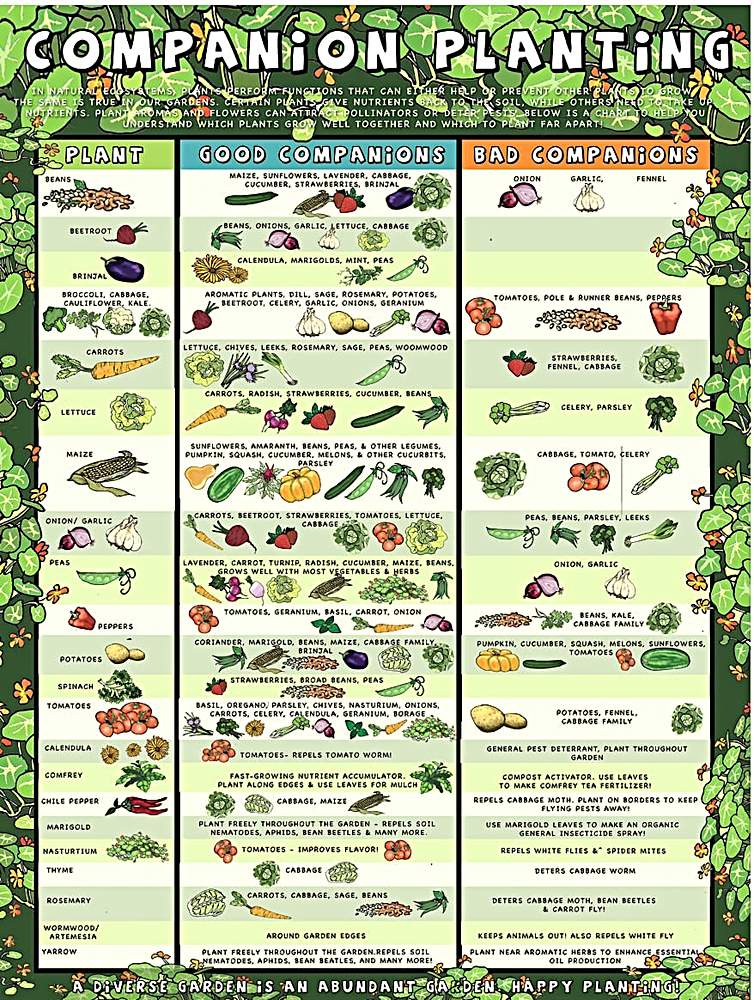Companion Plants – Increase Biodiversity

An informed appreciation of companion plants plays a big role in choosing the best plants for vegetable garden.
What is Companion Planting?
Companion planting is the practice of growing particular plants close to one another so that they can benefit from each other’s traits and nutrients. For example:
Attract Pollinators
In order to attract helpful insects to your vegetable garden, include some blooming herbs or annuals. Cucumbers and zucchini, for example, have both male and female flowers and require a visit from a bee or another pollinator to transport pollen from the male to the female flower so that fruit may grow.
Consider planting flowers like Calendula, Cosmos, Alyssum, Coreopsis, Echinacea, Marigolds, Violas and Zinnias at the edges of your garden beds to attract pollinators and add colour.
Inversely, Repel insects
See Companion Plants that repel insects.
Companion Plant Chart
About the companion plants chart: Certain flowers and herbs are frequently listed as good companions for crops. This is usually because they are excellent at deterring pests (see the previous post). Cabbage family = Broccoli, Brussels Sprouts, Cabbage, Cauliflower, Chinese Cabbage, Kale, Kohlrabi. In some cases, companion plants are known to improve flavor or on the flip side, stunt growth.
The chart below is not definitive – while these are the most common companion planting combinations, there are others. We’ve used multiple sources for this list and only added the companion plants when the lists agreed with one another.
Source: Various, including here
A Summary of the Objectives of Companion Planting
Trap cropping
Using one plant to “capture” insects which are harmful to another plant.
Nitrogen fixation:
Planting legumes like beans, peas, and clover amid nitrogen heavy feeders like corn or potatoes to restore nitrogen to the soil. Legumes derive their nitrogen from the air, not the soil.
Weed suppression:
Plants such as squash, with their large foliage, shade out weeds and cool the roots among tall plants like corn and sunflowers.
Improvement of the soil in the root zone:
Perhaps deciduous trees shade your lettuce and spinach late in the day. The trees also provide nutrients in the form of autumn leaves and carbon, which helps the soil retain moisture. When clover is planted around broccoli, it keeps the soil moist and cool, enhancing broccoli’s growth.
Insect control:
Certain plants produce chemicals from their roots or aerial parts that repel pests. For instance, it is well-documented that the roots of marigolds repel pest nematodes.
Spatial interactions:
Tall-growing plants like sunflowers can shade low growing, shade-tolerant spinach. When corn is planted with squash, it is believed that the prickly vines of squash dissuade raccoons from eating the corn.
Reduced plant diseases:
When peas and grains are planted together, Asochyta blight is significantly reduced. The grain crop modifies the canopy microclimate, making it less humid and reduces the raindrop splash effect, by which the blight spores are spread.
Beneficial insect habitats:
Companion plants can provide a desirable environment for beneficial insects, arthropods, and predatory species like ladybird beetles, lacewings, spiders, predatory wasps, and predatory mites which help keep insect populations in check.
